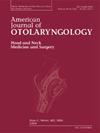Trends in postoperative complications following pediatric tonsillectomy & adenoidectomy: A 10-year analysis
IF 1.7
4区 医学
Q2 OTORHINOLARYNGOLOGY
引用次数: 0
Abstract
Objective
Assess the rates of post-operative complications following tonsillectomy with/without adenoidectomy over a 10-year span, comparing young children and adolescents, while examining the influence of comorbidities, social determinants of health, and potential racial, and gender differences.
Methods
A retrospective cohort study using TriNetX database with de-identified electronic medical records from 57 healthcare organizations for ages 0–17 who had tonsillectomy with/without adenoidectomy from January 2014 to December 2023. Risk analysis and incidence proportion over a 10-year period for 5 outcomes occurring within 30 days, stratified by gender, race, and ethnicity. Then further subdivided into two groups: Early Childhood (0–9 years) and Adolescence (10–17 years). Statistical analysis included risk ratios (RR), and 95 confidence intervals (CI), with statistical significance set at p ≤ 0.05.
Results
Before propensity score matching, 197,885 pediatric patients were identified. Most common complications occurring within 30 days were pain (3.1 %), post-operative hemorrhage (2.3 %) with 1.3 % requiring re-operation for control, dehydration (2.1 %), infection (0.26 %), and acute respiratory complications (0.21 %). Before propensity score matching, Early Childhood cohort (0–9 years: n = 71,024) and Adolescence cohort (10–17 years: n = 126,861). After propensity matching, n = 56,036 for both groups. Early Childhood cohort had higher rates for potential health hazards related to socioeconomic and psychosocial circumstances (p = 0.013) and environmental tobacco smoke exposure-related risks (p = 0.016) than Adolescence cohort. No significant differences in complication risks were observed between the two pediatric age groups.
Conclusion
Rates of dehydration and acute respiratory distress have declined, while post-operative hemorrhage, and pain have been increasing, and observable racial differences continue to persist within these complications.
Level of Evidence: III
儿童扁桃体切除术和腺样体切除术后并发症的趋势:10年分析
目的评估扁桃体切除术合并/不合并腺样体切除术后10年的并发症发生率,比较幼儿和青少年,同时检查合并症、健康的社会决定因素以及潜在的种族和性别差异的影响。方法采用TriNetX数据库,对2014年1月至2023年12月57家医疗机构0-17岁扁桃体切除术合并/不合并腺样体切除术的电子病历进行回顾性队列研究。30天内发生的5种结局的10年风险分析和发病率,按性别、种族和民族分层。然后进一步细分为两组:幼儿期(0-9岁)和青春期(10-17岁)。统计分析包括风险比(RR)和95个置信区间(CI), p≤0.05为有统计学意义。结果在倾向评分匹配前,共发现197,885例儿科患者。30天内最常见的并发症是疼痛(3.1%)、术后出血(2.3%)(其中1.3%需要再次手术控制)、脱水(2.1%)、感染(0.26%)和急性呼吸道并发症(0.21%)。倾向评分匹配前,幼儿组(0-9岁:n = 71,024)和青少年组(10-17岁:n = 126,861)。倾向匹配后,两组n = 56,036。与青少年组相比,幼儿组与社会经济和社会心理环境相关的潜在健康危害(p = 0.013)和与环境烟草烟雾暴露相关的风险(p = 0.016)的比例更高。在两个儿童年龄组之间观察到并发症风险无显著差异。结论脱水和急性呼吸窘迫发生率下降,而术后出血和疼痛发生率增加,且在这些并发症中存在明显的种族差异。证据水平:III
本文章由计算机程序翻译,如有差异,请以英文原文为准。
求助全文
约1分钟内获得全文
求助全文
来源期刊

American Journal of Otolaryngology
医学-耳鼻喉科学
CiteScore
4.40
自引率
4.00%
发文量
378
审稿时长
41 days
期刊介绍:
Be fully informed about developments in otology, neurotology, audiology, rhinology, allergy, laryngology, speech science, bronchoesophagology, facial plastic surgery, and head and neck surgery. Featured sections include original contributions, grand rounds, current reviews, case reports and socioeconomics.
 求助内容:
求助内容: 应助结果提醒方式:
应助结果提醒方式:


